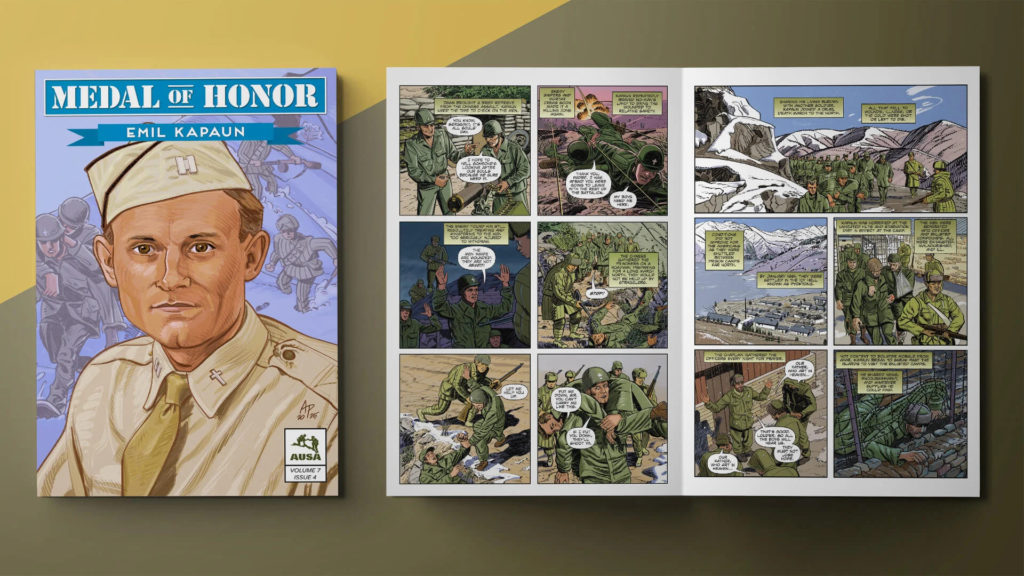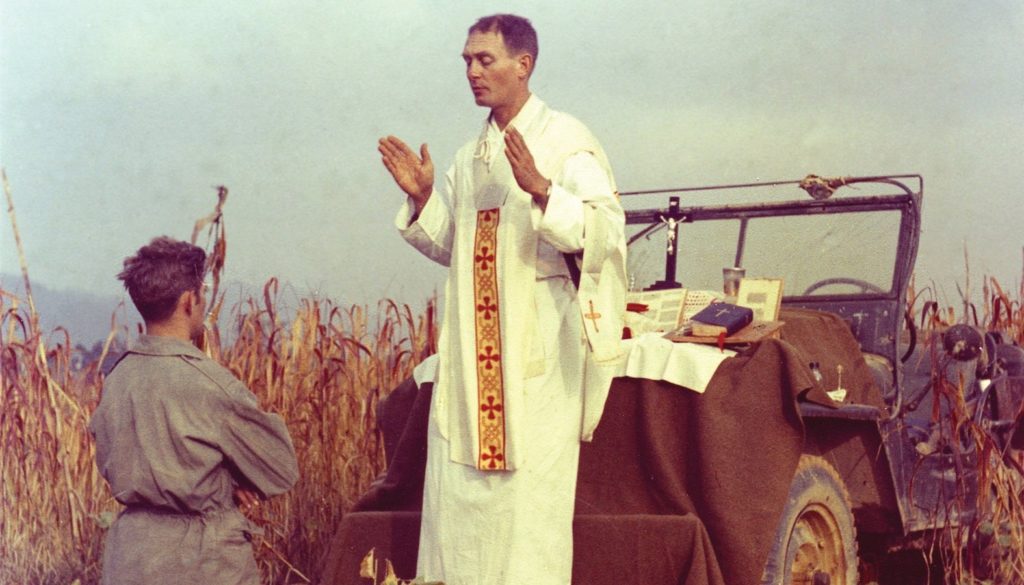Emil Kapaun (1916-1951), a Catholic priest and U.S. Army Chaplain from Kansas, exhibited heroic virtue as a POW during the Korean War.
Born in the small farming community of Pilsen, Kapaun was ordained in June 1940, and at the age of 24, assigned to his home parish in Kansas.
At the outbreak of World War II, he volunteered as an auxiliary chaplain at an Army Air Corps base near his home. He entered the U.S. Chaplain Corps in 1944, served during the war in the Burma India Theater, and with the Korean War brewing at the beginning of 1950 was posted to Japan.
On June 25, 1950, North Korea invaded South Korea. In July, Kapaun and the 8th Cavalry Regiment of the Army’s 1st Cavalry Division were sent to defend the South. Determined to fight the spread of Communism, Father Kapaun quickly became known for his willingness to risk his own life in order to save his men. He rode an old bicycle and sometimes used the hood of his Jeep as an altar on which to celebrate Mass and hear confessions.
In August 1950, he received a Bronze Star for rescuing a wounded soldier in the midst of enemy fire.
The 8th Cavalry Regiment pushed into North Korea, which by the end of October had gained China as an ally. On Nov. 1, 1950, they endured a surprise attack by the Chinese Army at Unsan. When Father Kapaun’s commanders ordered evacuation, he chose to stay.
By the next day, the feast of All Souls, the Chinese had captured the regiment. By all accounts, during this time Father Kapaun refused to save his own skin, dodged bullets, and gave the Last Rites to as many dying soldiers as he could reach. He carried one man, whose leg had been shattered by shrapnel, in his arms to safety.
During the forced 60-mile march to a prison camp in the freezing cold, Father Kapaun shored up flagging spirits and encouraged his men to help those too wounded to walk.
He spent seven months as a POW. Nearly half the prisoners died that first winter: from cold, starvation, and lice infestations. Under such conditions, the will to live was all-important. Father Kapaun prayed to St. Dismas, the good thief, then stole extra rations for his men. He offered freezing prisoners his own clothes, bathed their wounds, exhorted them to keep going.
The guards ridiculed his faith. At night he slipped into huts to lead prisoners in prayer and administer the sacraments. “Just for a moment,” one said, “he could turn a mud hut into a cathedral.”

He had been forbidden to celebrate Easter Mass, but did so anyway, holding up a small crucifix he’d fashioned from sticks. But his own health was rapidly failing. Suffering from malnutrition, dysentery, pneumonia, and a blood clot in his leg, Father Kapaun was hauled off to a “hospital” that was really a death house and deprived of food and water. He lasted two days, and passed away on May 23, 1951.
His surviving fellow prisoners were freed two years later, and the Father Kapaun stories began trickling out.
Almost 70 years later, Herbert Miller, a Sgt. First Class whose leg had been shattered at the Battle of Unsan, described the ensuing forced march:
“Father Kapaun helped me along, sometimes he’d carry me, sometimes he’d put his arm around me, helping me hop on one leg. That’s the way we went, from there to prison camp. It was a long journey. God sent that man to me. As sure as I was born the Lord sent him and he obeyed. … You’ll never find a man like him, not on this side of heaven.”
He is the most decorated military chaplain in U.S. history and was posthumously awarded the military’s Medal of Honor in 2013.
“Medal of Honor: Emil Kapaun” is the latest entry in the Medal of Honor graphic novel series, issued by The Association of the United States Army.
This full-color digital book was created by a team of professional comic book veterans:
Script: Chuck Dixon (“Batman,” “The Punisher,” “The ’Nam”)
Artwork, Cover: Andrew Paquette (“Avengers,” “Daredevil,” “Hellraiser”)
Lettering: Troy Peteri (“Spider-Man,” “Iron Man,” “X-Men”)
You can view the graphic novel or download a free copy at ausa.org/moh.
Notes the association: “Known for his courage as much as his spiritual guidance, Kapaun stayed to treat the wounded when Chinese forces overwhelmed his unit during the Korean War. He was sent to a prisoner of war camp, where he gave his rations to fellow soldiers and defied his captors to lead prayer meetings.”
Part of a series started in October 2018, to date the association has published 28 of these eight-page issues, commemorating such heroes as Audie Murphy, Mary Walker, Daniel Inouye, Henry Johnson, and Roy Benavidez.
Father Emil Kapaun’s cause for sainthood is being promoted by the Diocese of Wichita. He was deemed Venerable by Pope Francis in February 2025.

